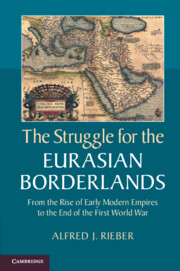 The Struggle for the Eurasian Borderlands
The Struggle for the Eurasian Borderlands Book contents
5 - Imperial crises
Published online by Cambridge University Press: 05 June 2014
Summary
From 1905 to 1911 all five multinational empires were shaken by constitutional crises that prefigured the greater upheavals and collapse of imperial rule in the period from 1917 to 1923. While each crisis had its particular domestic sources, all shared certain common characteristics. They signaled a major destabilization of imperial rule and a profound loss of legitimacy. They were precipitated both by the growing strength and militancy of socialist or nationalist movements in the borderlands, and by the pressure for economic and political change from powers outside the boundaries of Eurasia, primarily Britain, France, and Japan. The reactive impulses of the rulers, whether Franz Joseph, Nicholas II, Abdülhamid, Nasir al-Din, or the dowager empress – all of whom followed contradictory policies that promoted de-stabilizing institutional reforms while at the same time seeking to revive traditional ideologies – tended to intensify rather than disarm the forces of internal resistance and further to splinter the ruling elites. Disorders within one of the old rival powers often had consequences in the borderlands of neighboring states. A major reciprocal shock reverberated from the 1905 revolution in Russia. The centrality of Russia in the multiple crises of the first decade of the twentieth century was due to a number of factors: its contiguous and porous boundaries with all the other Eurasian states; the vigorous, not to say aggressive, conduct of its foreign policy in the west Balkans, Danubian frontier, Trans Caspia, and Inner Asia; and, finally, the widespread, if more diffuse, influence of the Russian revolutionary movements that spread across its frontiers either by imitation or direct transfer. The crises often, if not always, originated in conflicts over the borderlands where the ruling elites had failed to solve the most fundamental security problem of imperial rule; their first line of defense rested on unstable and vulnerable frontiers.
Although the dynastic rulers managed to weather the initial shock of the constitutional crises, they were all swept away in the second great period of revolution. The collapse of central authority in China after 1911, and the simultaneous defeat of the Habsburg, Ottoman, and Russian empires in 1917–1918, led to the dissolution of the empires, the breakaway or attempted breakaway of the borderlands, and a complex process of reconstituting new state systems on their ruined foundations.
- Type
- Chapter
- Information
- The Struggle for the Eurasian BorderlandsFrom the Rise of Early Modern Empires to the End of the First World War, pp. 424 - 531Publisher: Cambridge University PressPrint publication year: 2014


